Avisek Lahiri
LipSync3D: Data-Efficient Learning of Personalized 3D Talking Faces from Video using Pose and Lighting Normalization
Jun 08, 2021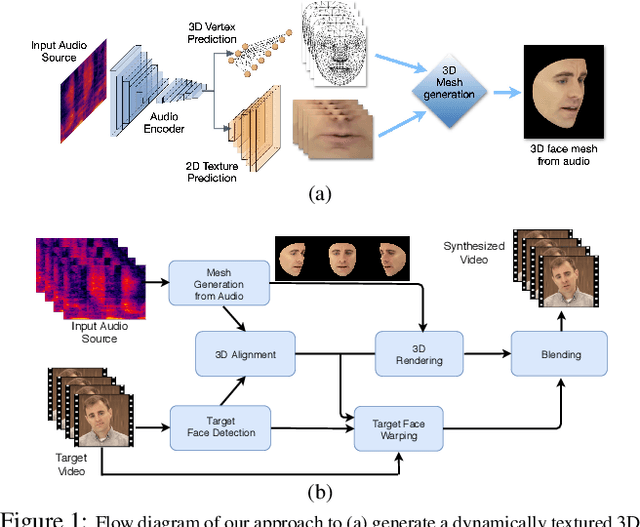
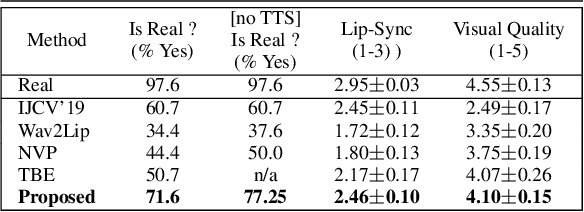
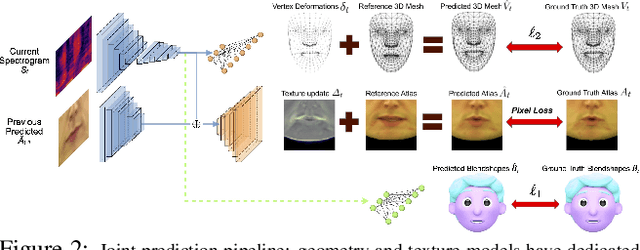

Abstract:In this paper, we present a video-based learning framework for animating personalized 3D talking faces from audio. We introduce two training-time data normalizations that significantly improve data sample efficiency. First, we isolate and represent faces in a normalized space that decouples 3D geometry, head pose, and texture. This decomposes the prediction problem into regressions over the 3D face shape and the corresponding 2D texture atlas. Second, we leverage facial symmetry and approximate albedo constancy of skin to isolate and remove spatio-temporal lighting variations. Together, these normalizations allow simple networks to generate high fidelity lip-sync videos under novel ambient illumination while training with just a single speaker-specific video. Further, to stabilize temporal dynamics, we introduce an auto-regressive approach that conditions the model on its previous visual state. Human ratings and objective metrics demonstrate that our method outperforms contemporary state-of-the-art audio-driven video reenactment benchmarks in terms of realism, lip-sync and visual quality scores. We illustrate several applications enabled by our framework.
Lightweight Modules for Efficient Deep Learning based Image Restoration
Jul 11, 2020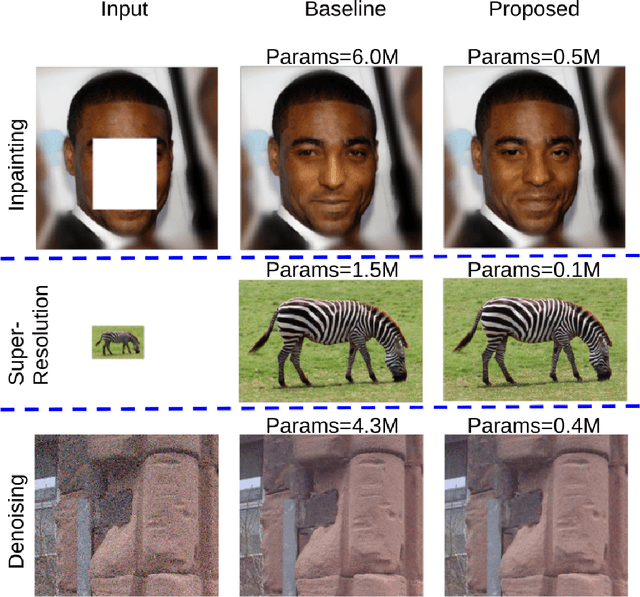
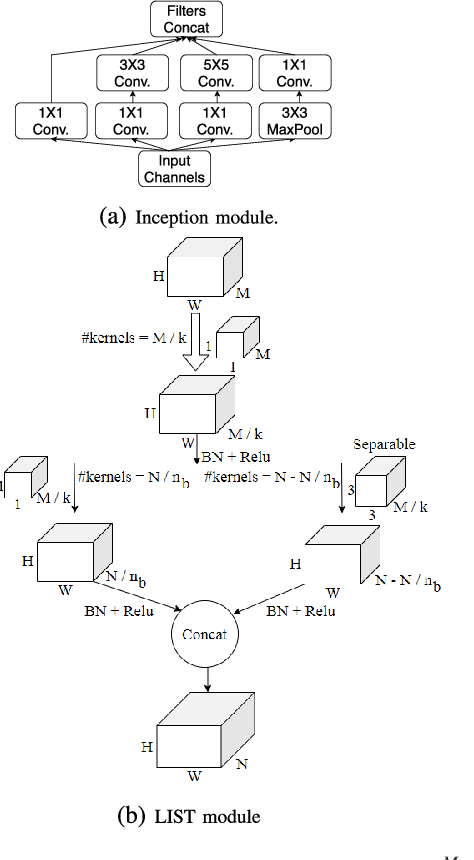
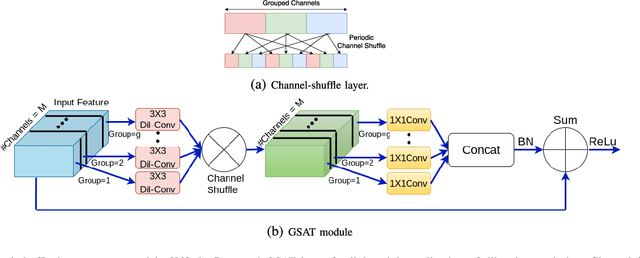
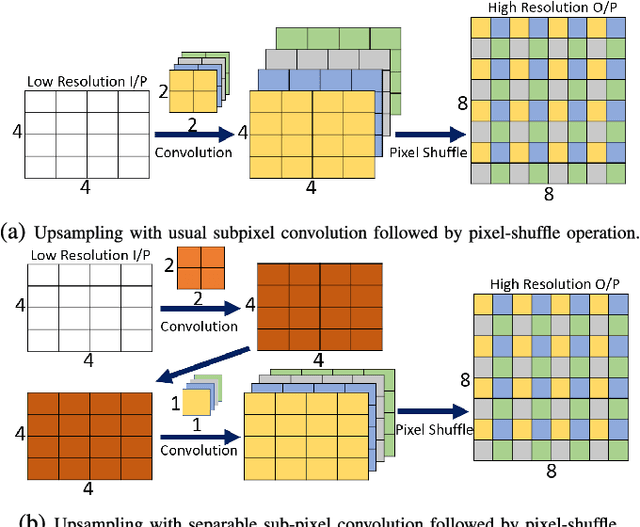
Abstract:Low level image restoration is an integral component of modern artificial intelligence (AI) driven camera pipelines. Most of these frameworks are based on deep neural networks which present a massive computational overhead on resource constrained platform like a mobile phone. In this paper, we propose several lightweight low-level modules which can be used to create a computationally low cost variant of a given baseline model. Recent works for efficient neural networks design have mainly focused on classification. However, low-level image processing falls under the image-to-image' translation genre which requires some additional computational modules not present in classification. This paper seeks to bridge this gap by designing generic efficient modules which can replace essential components used in contemporary deep learning based image restoration networks. We also present and analyse our results highlighting the drawbacks of applying depthwise separable convolutional kernel (a popular method for efficient classification network) for sub-pixel convolution based upsampling (a popular upsampling strategy for low-level vision applications). This shows that concepts from domain of classification cannot always be seamlessly integrated into image-to-image translation tasks. We extensively validate our findings on three popular tasks of image inpainting, denoising and super-resolution. Our results show that proposed networks consistently output visually similar reconstructions compared to full capacity baselines with significant reduction of parameters, memory footprint and execution speeds on contemporary mobile devices.
The Angel is in the Priors: Improving GAN based Image and Sequence Inpainting with Better Noise and Structural Priors
Aug 16, 2019
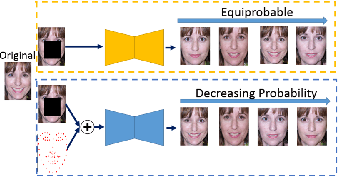
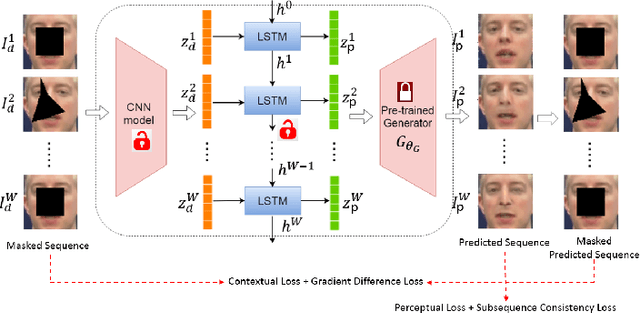
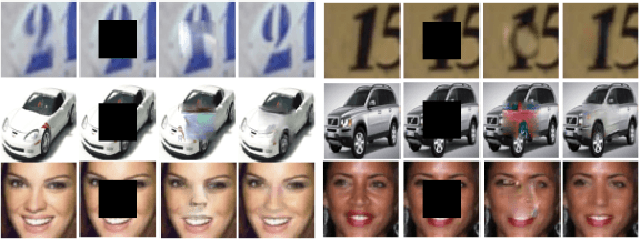
Abstract:Contemporary deep learning based inpainting algorithms are mainly based on a hybrid dual stage training policy of supervised reconstruction loss followed by an unsupervised adversarial critic loss. However, there is a dearth of literature for a fully unsupervised GAN based inpainting framework. The primary aversion towards the latter genre is due to its prohibitively slow iterative optimization requirement during inference to find a matching noise prior for a masked image. In this paper, we show that priors matter in GAN: we learn a data driven parametric network to predict a matching prior for a given image. This converts an iterative paradigm to a single feed forward inference pipeline with a massive 1500X speedup and simultaneous improvement in reconstruction quality. We show that an additional structural prior imposed on GAN model results in higher fidelity outputs. To extend our model for sequence inpainting, we propose a recurrent net based grouped noise prior learning. To our knowledge, this is the first demonstration of an unsupervised GAN based sequence inpainting. A further improvement in sequence inpainting is achieved with an additional subsequence consistency loss. These contributions improve the spatio-temporal characteristics of reconstructed sequences. Extensive experiments conducted on SVHN, Standford Cars, CelebA and CelebA-HQ image datasets, synthetic sequences and ViDTIMIT video datasets reveal that we consistently improve upon previous unsupervised baseline and also achieve comparable performances(sometimes also better) to hybrid benchmarks.
Faster Unsupervised Semantic Inpainting: A GAN Based Approach
Aug 14, 2019

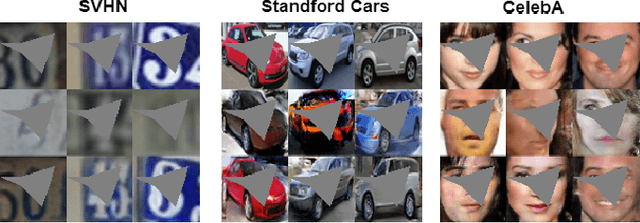
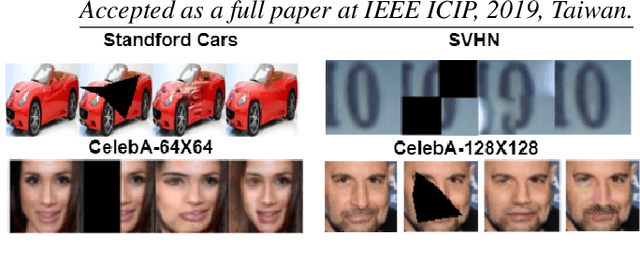
Abstract:In this paper, we propose to improve the inference speed and visual quality of contemporary baseline of Generative Adversarial Networks (GAN) based unsupervised semantic inpainting. This is made possible with better initialization of the core iterative optimization involved in the framework. To our best knowledge, this is also the first attempt of GAN based video inpainting with consideration to temporal cues. On single image inpainting, we achieve about 4.5-5$\times$ speedup and 80$\times$ on videos compared to baseline. Simultaneously, our method has better spatial and temporal reconstruction qualities as found on three image and one video dataset.
Improved Techniques for GAN based Facial Inpainting
Oct 20, 2018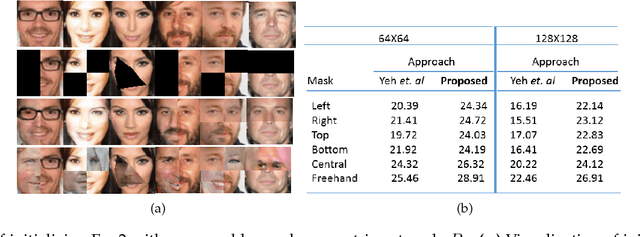



Abstract:In this paper we present several architectural and optimization recipes for generative adversarial network(GAN) based facial semantic inpainting. Current benchmark models are susceptible to initial solutions of non-convex optimization criterion of GAN based inpainting. We present an end-to-end trainable parametric network to deterministically start from good initial solutions leading to more photo realistic reconstructions with significant optimization speed up. For the first time, we show how to efficiently extend GAN based single image inpainter models to sequences by a)learning to initialize a temporal window of solutions with a recurrent neural network and b)imposing a temporal smoothness loss(during iterative optimization) to respect the redundancy in temporal dimension of a sequence. We conduct comprehensive empirical evaluations on CelebA images and pseudo sequences followed by real life videos of VidTIMIT dataset. The proposed method significantly outperforms current GAN based state-of-the-art in terms of reconstruction quality with a simultaneous speedup of over 15$\times$. We also show that our proposed model is better in preserving facial identity in a sequence even without explicitly using any face recognition module during training.
Unsupervised Domain Adaptation for Learning Eye Gaze from a Million Synthetic Images: An Adversarial Approach
Oct 18, 2018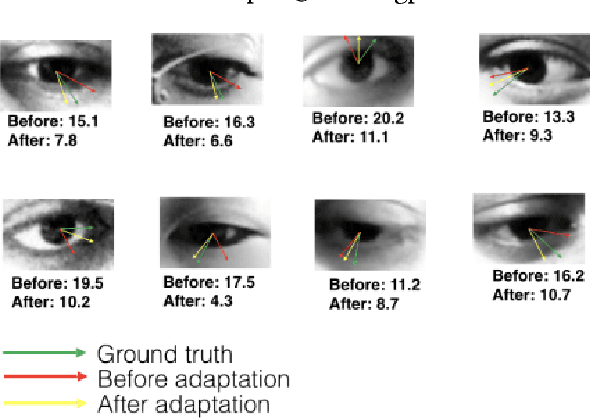
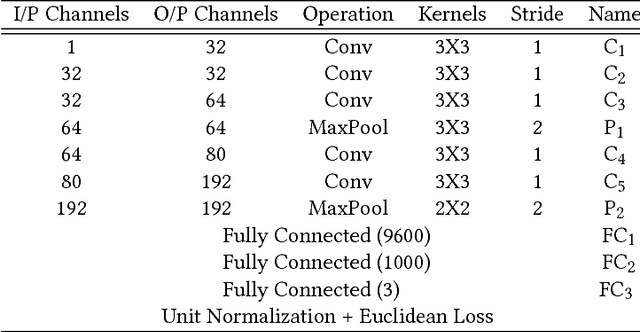


Abstract:With contemporary advancements of graphics engines, recent trend in deep learning community is to train models on automatically annotated simulated examples and apply on real data during test time. This alleviates the burden of manual annotation. However, there is an inherent difference of distributions between images coming from graphics engine and real world. Such domain difference deteriorates test time performances of models trained on synthetic examples. In this paper we address this issue with unsupervised adversarial feature adaptation across synthetic and real domain for the special use case of eye gaze estimation which is an essential component for various downstream HCI tasks. We initially learn a gaze estimator on annotated synthetic samples rendered from a 3D game engine and then adapt the features of unannotated real samples via a zero-sum minmax adversarial game against a domain discriminator following the recent paradigm of generative adversarial networks. Such adversarial adaptation forces features of both domains to be indistinguishable which enables us to use regression models trained on synthetic domain to be used on real samples. On the challenging MPIIGaze real life dataset, we outperform recent fully supervised methods trained on manually annotated real samples by appreciable margins and also achieve 13\% more relative gain after adaptation compared to the current benchmark method of SimGAN
Retinal Vessel Segmentation under Extreme Low Annotation: A Generative Adversarial Network Approach
Sep 05, 2018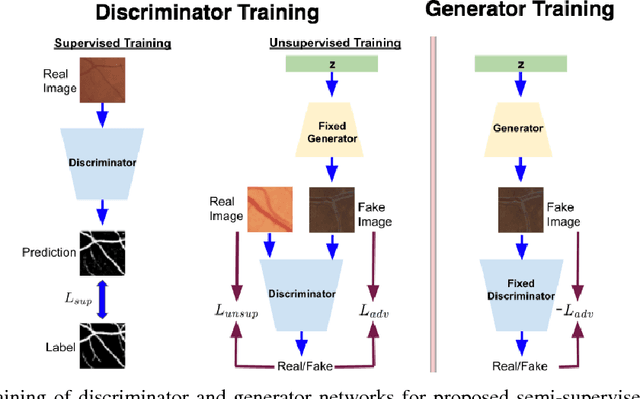
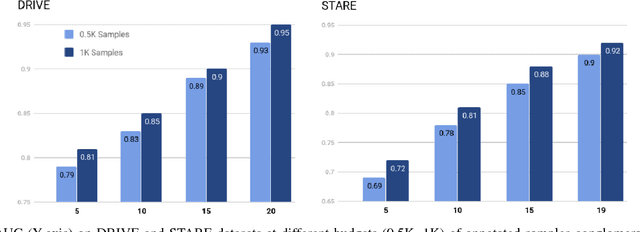
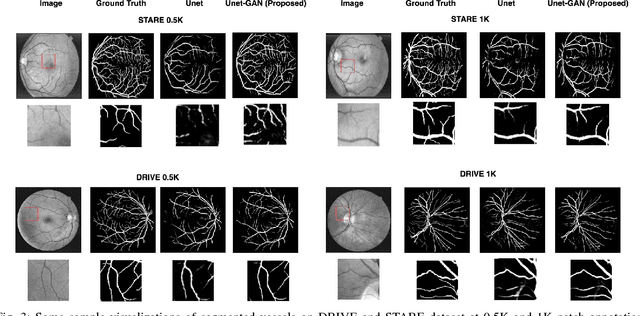

Abstract:Contemporary deep learning based medical image segmentation algorithms require hours of annotation labor by domain experts. These data hungry deep models perform sub-optimally in the presence of limited amount of labeled data. In this paper, we present a data efficient learning framework using the recent concept of Generative Adversarial Networks; this allows a deep neural network to perform significantly better than its fully supervised counterpart in low annotation regime. The proposed method is an extension of our previous work with the addition of a new unsupervised adversarial loss and a structured prediction based architecture. To the best of our knowledge, this work is the first demonstration of an adversarial framework based structured prediction model for medical image segmentation. Though generic, we apply our method for segmentation of blood vessels in retinal fundus images. We experiment with extreme low annotation budget (0.8 - 1.6% of contemporary annotation size). On DRIVE and STARE datasets, the proposed method outperforms our previous method and other fully supervised benchmark models by significant margins especially with very low number of annotated examples. In addition, our systematic ablation studies suggest some key recipes for successfully training GAN based semi-supervised algorithms with an encoder-decoder style network architecture.
Improving Consistency and Correctness of Sequence Inpainting using Semantically Guided Generative Adversarial Network
Nov 17, 2017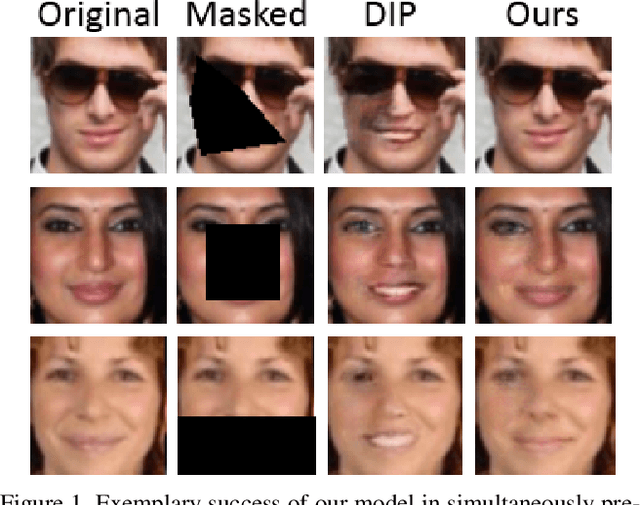
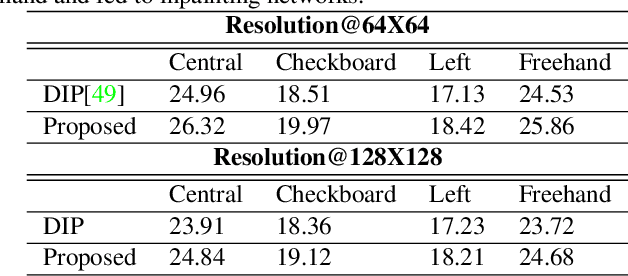
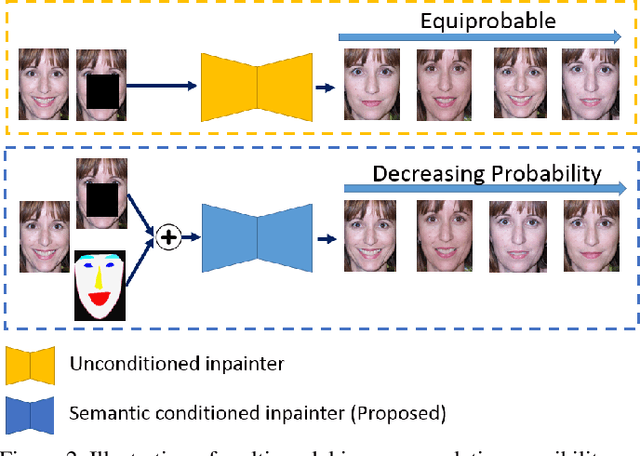

Abstract:Contemporary benchmark methods for image inpainting are based on deep generative models and specifically leverage adversarial loss for yielding realistic reconstructions. However, these models cannot be directly applied on image/video sequences because of an intrinsic drawback- the reconstructions might be independently realistic, but, when visualized as a sequence, often lacks fidelity to the original uncorrupted sequence. The fundamental reason is that these methods try to find the best matching latent space representation near to natural image manifold without any explicit distance based loss. In this paper, we present a semantically conditioned Generative Adversarial Network (GAN) for sequence inpainting. The conditional information constrains the GAN to map a latent representation to a point in image manifold respecting the underlying pose and semantics of the scene. To the best of our knowledge, this is the first work which simultaneously addresses consistency and correctness of generative model based inpainting. We show that our generative model learns to disentangle pose and appearance information; this independence is exploited by our model to generate highly consistent reconstructions. The conditional information also aids the generator network in GAN to produce sharper images compared to the original GAN formulation. This helps in achieving more appealing inpainting performance. Though generic, our algorithm was targeted for inpainting on faces. When applied on CelebA and Youtube Faces datasets, the proposed method results in a significant improvement over the current benchmark, both in terms of quantitative evaluation (Peak Signal to Noise Ratio) and human visual scoring over diversified combinations of resolutions and deformations.
Deep Neural Ensemble for Retinal Vessel Segmentation in Fundus Images towards Achieving Label-free Angiography
Sep 19, 2016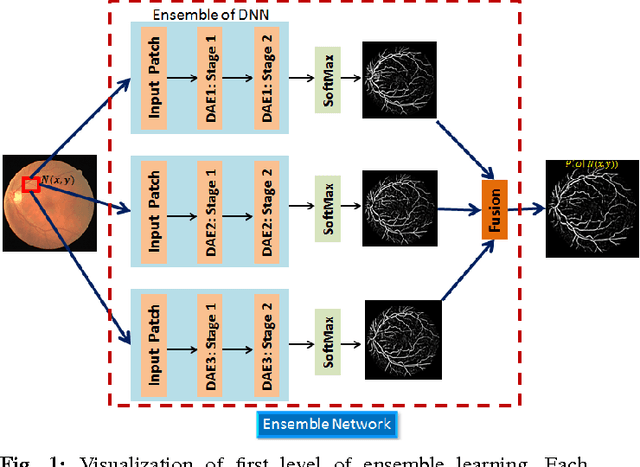
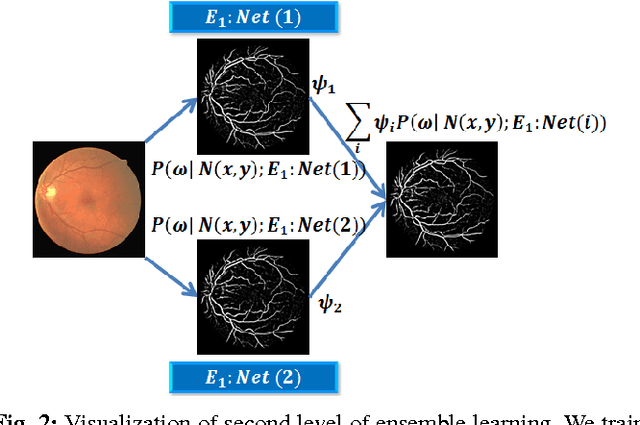
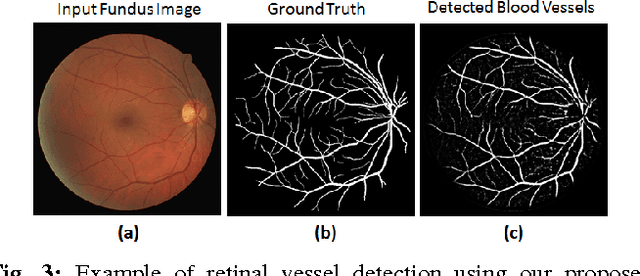
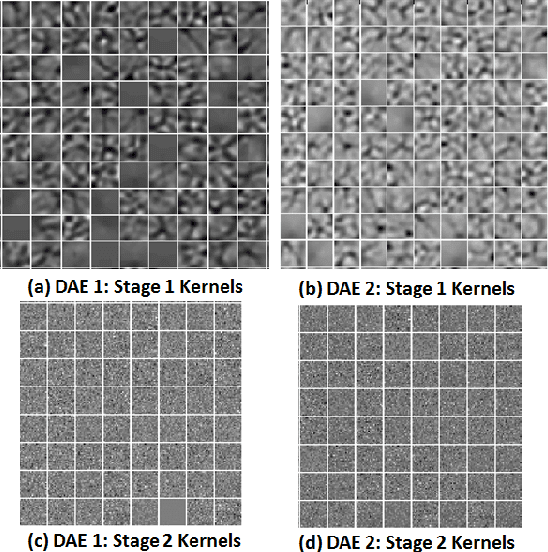
Abstract:Automated segmentation of retinal blood vessels in label-free fundus images entails a pivotal role in computed aided diagnosis of ophthalmic pathologies, viz., diabetic retinopathy, hypertensive disorders and cardiovascular diseases. The challenge remains active in medical image analysis research due to varied distribution of blood vessels, which manifest variations in their dimensions of physical appearance against a noisy background. In this paper we formulate the segmentation challenge as a classification task. Specifically, we employ unsupervised hierarchical feature learning using ensemble of two level of sparsely trained denoised stacked autoencoder. First level training with bootstrap samples ensures decoupling and second level ensemble formed by different network architectures ensures architectural revision. We show that ensemble training of auto-encoders fosters diversity in learning dictionary of visual kernels for vessel segmentation. SoftMax classifier is used for fine tuning each member auto-encoder and multiple strategies are explored for 2-level fusion of ensemble members. On DRIVE dataset, we achieve maximum average accuracy of 95.33\% with an impressively low standard deviation of 0.003 and Kappa agreement coefficient of 0.708 . Comparison with other major algorithms substantiates the high efficacy of our model.
Forward Stagewise Additive Model for Collaborative Multiview Boosting
Aug 05, 2016
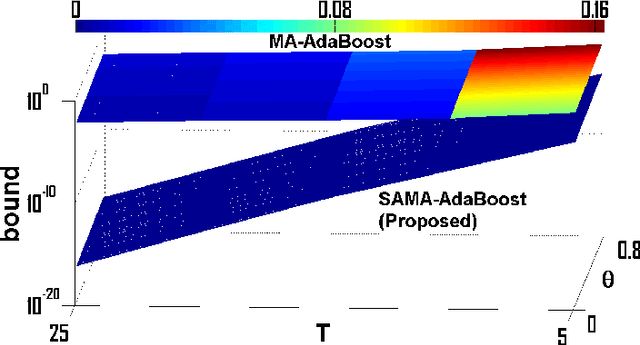
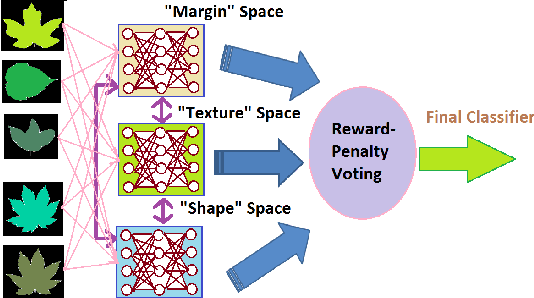
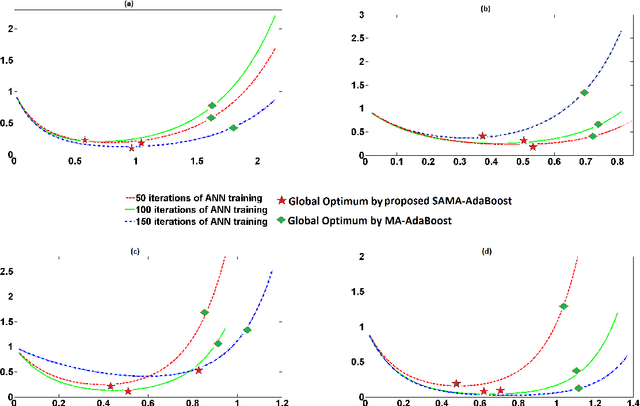
Abstract:Multiview assisted learning has gained significant attention in recent years in supervised learning genre. Availability of high performance computing devices enables learning algorithms to search simultaneously over multiple views or feature spaces to obtain an optimum classification performance. The paper is a pioneering attempt of formulating a mathematical foundation for realizing a multiview aided collaborative boosting architecture for multiclass classification. Most of the present algorithms apply multiview learning heuristically without exploring the fundamental mathematical changes imposed on traditional boosting. Also, most of the algorithms are restricted to two class or view setting. Our proposed mathematical framework enables collaborative boosting across any finite dimensional view spaces for multiclass learning. The boosting framework is based on forward stagewise additive model which minimizes a novel exponential loss function. We show that the exponential loss function essentially captures difficulty of a training sample space instead of the traditional `1/0' loss. The new algorithm restricts a weak view from over learning and thereby preventing overfitting. The model is inspired by our earlier attempt on collaborative boosting which was devoid of mathematical justification. The proposed algorithm is shown to converge much nearer to global minimum in the exponential loss space and thus supersedes our previous algorithm. The paper also presents analytical and numerical analysis of convergence and margin bounds for multiview boosting algorithms and we show that our proposed ensemble learning manifests lower error bound and higher margin compared to our previous model. Also, the proposed model is compared with traditional boosting and recent multiview boosting algorithms.
 Add to Chrome
Add to Chrome Add to Firefox
Add to Firefox Add to Edge
Add to Edge